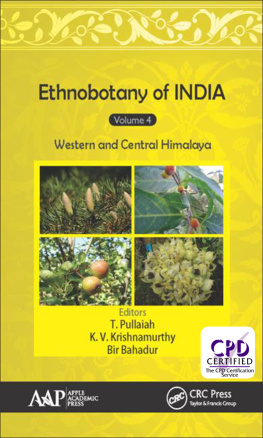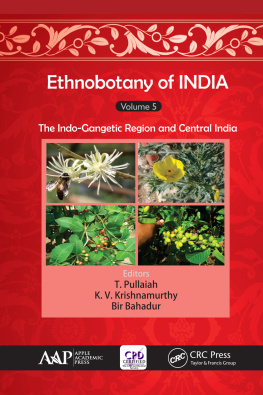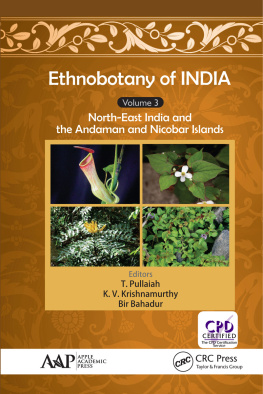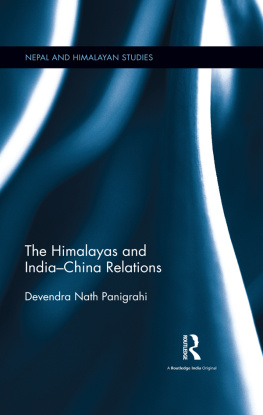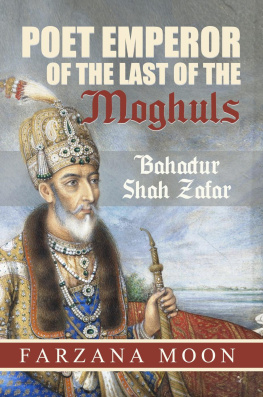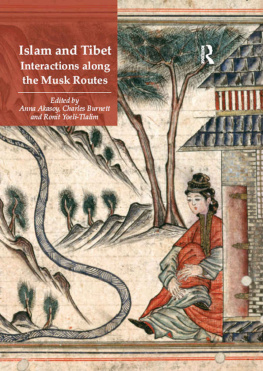Bahadur Bir - Ethnobotany of India, Volume 4 Western and Central Himalayas
Here you can read online Bahadur Bir - Ethnobotany of India, Volume 4 Western and Central Himalayas full text of the book (entire story) in english for free. Download pdf and epub, get meaning, cover and reviews about this ebook. City: India, year: 2017;2018, publisher: CRC Press LLC;Apple Academic Press, genre: Politics. Description of the work, (preface) as well as reviews are available. Best literature library LitArk.com created for fans of good reading and offers a wide selection of genres:
Romance novel
Science fiction
Adventure
Detective
Science
History
Home and family
Prose
Art
Politics
Computer
Non-fiction
Religion
Business
Children
Humor
Choose a favorite category and find really read worthwhile books. Enjoy immersion in the world of imagination, feel the emotions of the characters or learn something new for yourself, make an fascinating discovery.
- Book:Ethnobotany of India, Volume 4 Western and Central Himalayas
- Author:
- Publisher:CRC Press LLC;Apple Academic Press
- Genre:
- Year:2017;2018
- City:India
- Rating:5 / 5
- Favourites:Add to favourites
- Your mark:
- 100
- 1
- 2
- 3
- 4
- 5
Ethnobotany of India, Volume 4 Western and Central Himalayas: summary, description and annotation
We offer to read an annotation, description, summary or preface (depends on what the author of the book "Ethnobotany of India, Volume 4 Western and Central Himalayas" wrote himself). If you haven't found the necessary information about the book — write in the comments, we will try to find it.
Bahadur Bir: author's other books
Who wrote Ethnobotany of India, Volume 4 Western and Central Himalayas? Find out the surname, the name of the author of the book and a list of all author's works by series.
Ethnobotany of India, Volume 4 Western and Central Himalayas — read online for free the complete book (whole text) full work
Below is the text of the book, divided by pages. System saving the place of the last page read, allows you to conveniently read the book "Ethnobotany of India, Volume 4 Western and Central Himalayas" online for free, without having to search again every time where you left off. Put a bookmark, and you can go to the page where you finished reading at any time.
Font size:
Interval:
Bookmark:

We wish to express our grateful thanks to all the authors who have contributed their chapters. We thank them for their cooperation and erudition. We also thank several colleagues for their help in many ways and for their suggestions from time to time during the evolution of this volume.
We wish to express our appreciation and help rendered by Ms. Sandra Jones Sickels and her staff at Apple Academic Press. Above all, their professionalism that has made this book a reality is greatly appreciated.
We thank Mr. John Adams, Senior Research Fellow of Prof. K. V. Krishnamurthy for his help in many ways.
We wish to express our grateful thanks to our respective family members for their cooperation.
We hope that this book will help our fellow teachers and researchers who enter the world of the fascinating subject of ethnobotany in India with confidence.
Editors
Editors: T. Pullaiah, PhD, K. V. Krishnamurthy, PhD, and Bir Bahadur, PhD
Volume 1: Eastern Ghats and Deccan
Volume 2: Western Ghats and West Coast of Peninsular India
Volume 3: North-East India and the Andaman and Nicobar Islands
Volume 4: Western and Central Himalayas
Volume 5: The Indo-Gangetic Region and Central India
S. John Adams
R&D, Phytochemistry and Pharmacognosy, Sami Labs Ltd., Peenya Industrial Area, Bangalore, India, E-mail:
Bir Bahadur
Department of Botany, Kakatiya University, Warangal - 505009, India,
Basant Ballabh
Defence Institute of Bio-Energy Research, Defence Research & Development Organization, Goraparao, Haldwani, Uttarakhand, India, E-mail:
O. P. Chaurasia
Defence Institute of High Altitude Research, Defence Research and Development Organization, Leh-Ladakh, Jammu and Kashmir, India
Shalu Devi
Faculty of Forestry, Sher-e-Kashmir University of Agricultural Science and Technology, Benihama, Srinagar - 191121, Jammu & Kashmir, India, E-mail:
Veena Dixit
Plant diversity, Systematics and Herbarium division, CSIR-National Botanical Research Institute, Lucknow - 226001, Uttar Pradesh, India
Yogesh Gokhale
The Energy and Resources Institute (TERI), New Delhi, India, E-mail:
Vaneet Jishtu
Himalayan Forest Research Institute, Shimla - 171009, Himachal Pradesh, India, E-mail:
K. V. Krishnamurthy
Consultant, R&D, Sami Labs, Peenya Industrial Area, Bangalore - 560058, Karnataka, India
T. Senthil Kumar
Department of Plant Science, Bharathidasan University, Tiruchirapalli - 620024, India
T. N. Manohara
Bioprospecting and Indigenous Knowledge Division, Rain Forest Research institute. Po. Box. 136, Jorhat, Assam, India.
Anju Majeed
R&D-Phytochemistry and Pharmacognosy, Sami Labs Ltd., Peenya Industrial Area, Bangalore, India
G. Muthuraman
R&D-Phytochemistry and Pharmacognosy, Sami Labs Ltd., Peenya Industrial Area, Bangalore, India
Chandra Singh Negi
Department of Zoology, Government Postgraduate College, Pithoragarh, Uttarakhand - 262502, India, E-mail:
Nazir A. Pala
Department of Forestry, Faculty of Horticulture, Uttar Banga Krishi Viswavidyalaya, Pundibari - 736165, Cooch Behar (WB), India, E-mail:
P. C. Pande
Department of Botany, Kumaum University, Nainital, Uttarakhand, India
T. Pullaiah
Department of Botany, Sri Krishnadevaraya University, Anantapur - 515003, A.P., India,
E-mail:
A. Rajasekaran
Institute of Forest Genetics and Tree Breeding, Coimbatore - 641002, Tamil Nadu, India,
E-mail:
Mamta Sharma
Department of Botany, Himachal Pradesh University, Shimla - 171005, Himachal Pradesh, India, E-mail:
Harsh Singh
Department of Botany, University of Lucknow, Lucknow - 226007, Uttar Pradesh, India,
E-mail:
Jagdish Singh
Himalayan Forest Research Institute, Shimla-171009, Himachal Pradesh, India,
E-mail:
Joginder Singh
Himalayan Forest Research Institute, Shimla - 171009, Himachal Pradesh, India, E-mail:
S. K. Sood
Department of Botany, Himachal Pradesh University, Shimla - 171005, Himachal Pradesh, India
S. P. Subramani
Institute of Forest Genetics and Tree Breeding, Coimbatore - 641002, Tamil Nadu, India, E-mail:
1 Department of Botany, Kakatiya University, Warangal 505009, India
2 Consultant, R&D, Sami Labs, Peenya Industrial Area, Bangalore 560058, Karnataka, India
3 Department of Botany, Sri Krishnadevaraya University, Anantapur 515003, A.P., India,
E-mail:
This introductory chapter deals with the scope of this volume. It gives a general account on the Western and Central Himalayas (covering the States of Jammu & Kashmir, Himachal Pradesh and Uttarakhand), particularly the physical location, geology, climate and vegetation. It also introduces the other chapters of this volume which are related to the ethnic diversity, various aspects of ethno-traditional knowledge systems and ethnic conservation strategies.
The Indian subcontinent of Asia consists of the Himalayas, Indo-Gangetic plains, Peninsular India with its uplands and plateaus and the Narrow coastal plains along the seaboards (Valdiya, 2010). The Himalayas form the mountainous province that girdles the northern border of India. It is a structurally, lithologically, physiographically and evolutionarily distinct province that separates India from the rest of Eurasia. The composite Himalayas comprises the Kirthar and the Sulaiman mountain chains in the west, the main Himalayas in the center and the Patkai-Naga-Arakan-Yoma mountain ranges in the east. The Himalayas forms a 2,400 km long and 300-400 km wide region and embodies four physiographically different terrenes: the Siwalik, the Himachal (Lesser Himalayas), the Himadri (Greater Himalayas) and the Tethys Himalayas. The Siwalik Terrane abruptly rises above the almost flat Indo-Gangetic plains, is about 250 to 800 m. height and forms the southern front of Himalayas. It is mainly made up of the sedimentary deposits by ancient Himalayan rivers in the last 16 to 1.5 million years. The Siwalik is often broken by south-facing scarps and show long, and flat stretches called Duns.
Lying north of Siwalik is the outer Lesser Himalayas or Himachal which consists of Pir Panjal-Dhauladhar-Mussorie-Nainital-Mahabharat Ranges (generally more than 2,000 m high). North of these in the central sector (Kumaun and Nepal) is the Middle Lesser Himalayas (600-2,000 m high). The valleys of the rivers like Ravi, Sutlej, Yamuna, Ganga, Kali, Karnali, Kandaki, Kosi, Arun and Subansiri (most of these rivers are older than the regions which they cross) are characterized by deep gorges and defiles (Valdiya, 2010). The rocks of Lesser Himalayas are Precambrian and are more than 540 million years of age; these are often found along with volcanic and sedimentary rocks.
The Himadri or Greater Himalayas is perennially snow-capped and extremely rugged (with a height from 3,000 to 8,000 m). There are many mountain peaks such as Nanga Parbat (8,126 m), Nun-Kum (7,817 m), Daulagiri (8,172 m), Sagarmatha or Everest (8,848 m), Kanchanjungha (8,598 m) and Namcha Barwa (7,756 m). This region of Himalayas is made up of high-grade metamorphic rocks and gneissic granites.
Beyond Himadri is the Tethys Himalayas which has sedimentary rocks of late Precambrian (more than 600 million years old) to the Cretaceous and Eocene (95-45 million years old). It is a cold desert and is without vegetation. This Himalayan region ends up against the zone of collision of India with Asia, which is a 50-60 km wide zone of continental junction (36005000 m high). North of this is Tibet plateau. This Himalayan zone, also called Trans-Himalayas, makes up the Ladakh-Kailas-Gangadese ranges (Valdiya, 2010).
Font size:
Interval:
Bookmark:
Similar books «Ethnobotany of India, Volume 4 Western and Central Himalayas»
Look at similar books to Ethnobotany of India, Volume 4 Western and Central Himalayas. We have selected literature similar in name and meaning in the hope of providing readers with more options to find new, interesting, not yet read works.
Discussion, reviews of the book Ethnobotany of India, Volume 4 Western and Central Himalayas and just readers' own opinions. Leave your comments, write what you think about the work, its meaning or the main characters. Specify what exactly you liked and what you didn't like, and why you think so.

